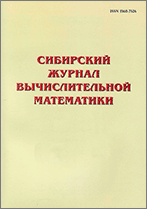|
|
Sibirskii Zhurnal Vychislitel'noi Matematiki, 2007, Volume 10, Number 2, Pages 159–175
(Mi sjvm74)
|
 |
|
 |
This article is cited in 1 scientific paper (total in 1 paper)
Optimal detection of a given number of unknown quasiperiodic fragments in a numerical sequence
A. V. Kel'manov, S. A. Khamidullin
Sobolev Institute of Mathematics, Siberian Branch of the Russian Academy of Sciences
Abstract:
The a posteriori approach to the problem of the noise-proof detection of unknown quasiperiodic fragments in a numerical sequence is studied. It is assumed that the number of elements in the fragments is given. The case is analyzed, where (1) the number of fragments is known; (2) the index of a sequence term corresponding to the beginning of a fragment is a deterministic (not random) value; (3) a sequence distorted by an additive uncorrelated Gaussian noise is available for observation. It is established that the problem under consideration is reduced to testing a set of hypotheses about the mean of a random Gaussian vector. It is shown that the search for a maximum-likelihood hypothesis is equivalent to finding the arguments which yield a maximum for auxiliary object function. It is proven that maximizing this auxiliary object function is a polynomial-solvable discrete optimization problem. An exact algorithm for solving this auxiliary problem is substantiated. We derive and prove an algorithm for the optimal (maximum-likelihood) detection of fragments. The kernel of this algorithm is the algorithm for solution to an auxiliary problem. The results of numerical simulation are presented.
Key words:
numerical sequence, a posteriori processing, quasiperiodic fragment, optimal detecting, effective algorithm.
Received: 07.03.2006
Citation:
A. V. Kel'manov, S. A. Khamidullin, “Optimal detection of a given number of unknown quasiperiodic fragments in a numerical sequence”, Sib. Zh. Vychisl. Mat., 10:2 (2007), 159–175
Linking options:
https://www.mathnet.ru/eng/sjvm74 https://www.mathnet.ru/eng/sjvm/v10/i2/p159
|

| Statistics & downloads: |
| Abstract page: | 434 | | Full-text PDF : | 112 | | References: | 84 |
|




 Contact us:
Contact us: Terms of Use
Terms of Use
 Registration to the website
Registration to the website Logotypes
Logotypes









 Citation in format
Citation in format 
